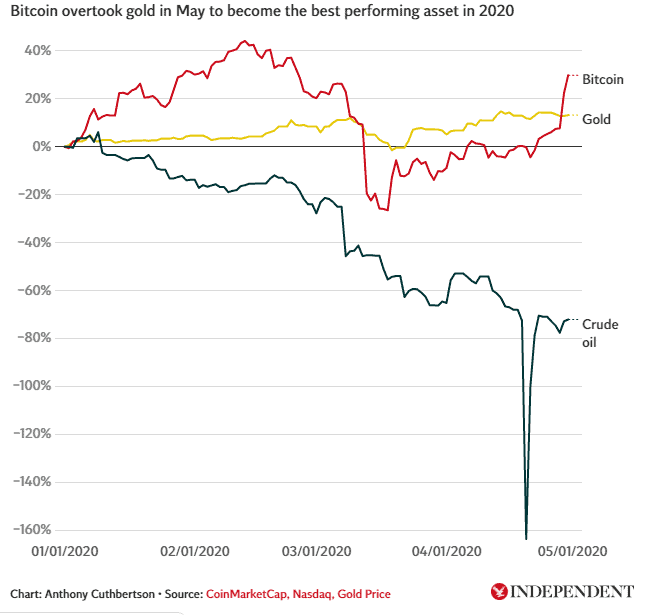Bitcoin’s halving, or the halvening, happens every four years. What does this mean to the future of this digital currency?
In the midst of global economy uncertainty right now and major world currencies dropping, one digital currency, Bitcoin is starting to see changes when the prices surged in the past few weeks.
This is due to a phenomenon known as halving, or the halvening. Every four years, the amount of new coins that bitcoin investors (or also known as miners) receive as a reward for mining a block of bitcoins is cut in half.
The miners now receive 6.25 bitcoin instead of 12.5 bitcoin. This will be the third time bitcoin halving has occurred in history. The first one happened during 2012, followed by 2016, and the next one will take place sometime in 2024 where we expect a reduction in the number of new bitcoins to 3.125.
Contents
Why The Halvening?
The halvening cuts the production of bitcoin in half in such a way that mining the cryptocurrency only generates 50% of the yield it used to.
Halving was written into the cryptocurrency’s code by its creator, Satoshi Nakamoto, to control inflation.
Bitcoin’s code also means that rewards to miners will continue to halve every 210,000 blocks until they reach zero in around two decades’ time, limiting the total number of bitcoins that will ever exist to 21 million.
This is because – unlike currencies such as the Dollar, Pound etc, bitcoin doesn’t have a central bank to manage the supply.
“NYTimes 09/Apr/2020 With $2.3T Injection, Fed’s Plan Far Exceeds 2008 Rescue” ~Bitcoin Halving secret message referring to New York Times article where US Federal Reserve pumped $2.3 trillion into the economy in response to the Covid-19 crisis. Some analysts see this message as a warning of an approaching financial crisis.
So what’s next after bitcoin’s halving?
Previous halvings have resulted in sharp price increases and severe market volatility for bitcoin and other cryptocurrencies, as traders and miners adjust to the new production limitations of the world’s most valuable virtual currency.
For most of last week leading to the halving, bitcoin began a steady ascent from $9,000 to around $9,600. On Friday at time of article publication, the price of bitcoin had dropped from roughly $9,640 to around $8,650 before recovering to $9,500.
The latest bitcoin’s halving comes during a global economic crisis, and though it’s not clear yet whether collapsing markets is driving money away from traditional assets into cryptocurrency. Some analysts claim that bitcoin is becoming save-haven asset similar to gold, and investors may already be looking towards it as an alternative store-of-value.

(Source: CoinMarketCap, Nasdaq, published on The Independent)
Demand for bitcoin may increase as investors view it as safer than government-backed paper currencies in the time of Covid-19 and extraordinary easing measures from the Fed and other central banks (in America).
Investors should be cautious and not rely on previous prices to determine whether they should increase their allocation to cyptocurrencies
“We are in a period of global asset price deflation. We do not want to send a message to investors that they will be okay if they want to buy digital assets because a lot of factors are in play right now. They would be better off being conservative in their strategy and managing risks properly, and not putting their faith in historical patterns. The bull run may not happen a third time in a row,” said Sinegy market research and compliance officer John Sidoli.
Overall
It’s still too early to say that bitcoin is easy money considering that digital currencies are incredibly volatile. We should wait and see how our current situation with global economy will pan out for the cryptocurrencies.
For Malaysia, bitcoin is still under a fuzzy legal area but it’s not entirely banned by the government. According to Bank Negara Malaysia, bitcoin and other cryptocurrency are not recognized as a legal tender and the public should carefully evaluate the risks associated with dealings in digital assets. Cryptocurrency is regulated by the Securities Commission as Digital Currency and Digital Token with three crypto exchange operators in June last year: Luno Malaysia, Sinegy Technologies, and Tokenize Technology. Luno and Tokenize have since received full approval.
You May Also Like
- Comparing Bitcoin and Cryptocurrency Exchanges
- Storing Documents on the Blockchain
- The History of Cryptography to Cryptocurrency
- You Can’t Change the Crypto World in a Smooth Predictable Curve
- Luno Malaysia Cryptocurrency Exchange Relaunch
What do you think will happen to bitcoin future after the halving? Share with us in the comments section below.






Leave A Comment